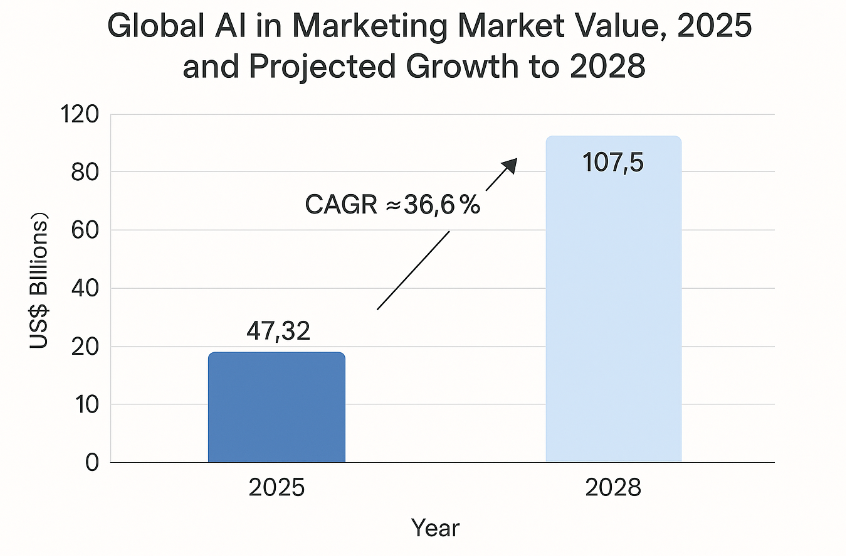This article explores the latest AI-powered strategies that deliver higher ROI, more precise audience targeting, and smarter automation for digital advertisers.
The New Era of AI-Driven Advertising
The digital advertising landscape in 2025 looks nothing like it did just a few years ago. Artificial intelligence has moved from being a helpful assistant to becoming the core engine of campaign success. From creative optimization to audience segmentation and predictive analytics, AI now shapes every stage of the advertising process.

Global AI in Marketing Market Value, 2025 and Projected Growth to 2028
According to Statista (2025), 82% of marketing leaders are now using some form of AI technology to manage or analyze their advertising efforts—an increase of 35% since 2022. The reason is clear: campaigns that integrate AI consistently outperform traditional approaches in both efficiency and profitability.
1. Smarter Audience Targeting
In 2025, audience targeting isn’t about guessing—it’s about precision. AI models can process billions of behavioral data points, from online purchase history to real-time social media engagement, to identify exactly who is most likely to convert.
Recent data from Marketing Week’s Global Ad Intelligence Report (2025) shows that AI-enhanced targeting improves conversion rates by an average of 43%, while reducing cost-per-acquisition by 28%. This allows businesses to reach their ideal customers without wasting budget on irrelevant impressions.
2. Creative Optimization at Scale
Creating multiple ad variations used to take hours of manual design and copywriting. AI tools now automate this process—testing headlines, visuals, and calls-to-action across different audiences. They use performance data to instantly adjust creative elements for maximum engagement.
Research by HubSpot (2025) found that campaigns using AI for creative optimization saw 2.7x higher engagement rates compared to those relying solely on human testing cycles. AI doesn’t replace human creativity—it enhances it by turning insights into scalable, real-time improvements.
3. Predictive Campaign Analytics
The most powerful feature of modern AI advertising is its predictive capability. By analyzing historical performance, seasonal trends, and audience behavior, AI can forecast the best times to launch campaigns, how much to bid, and even which creative assets will perform best.

Projected Global Programmatic Ad Spend in 2025
For example, predictive models in programmatic advertising have reduced wasted ad spend by up to 38%, according to AdExchanger’s 2025 Programmatic Benchmark Report. This allows marketers to allocate resources where they truly matter—maximizing results and minimizing inefficiency.
4. Automation and Workflow Efficiency
AI doesn’t just improve performance; it also saves time. Campaign automation now covers everything from A/B testing to budget reallocation and audience updates. What used to take teams hours or days can now happen in real-time.
By 2025, advertisers report saving an average of 12 hours per week through AI-powered automation, freeing teams to focus on strategy and creativity rather than repetitive manual tasks.
5. Ethical and Transparent AI Use
As AI takes a leading role in campaign management, transparency becomes crucial. Marketers must ensure that algorithms are trained on ethical data sources and that personalization respects user privacy. Responsible AI implementation is now a core part of brand trust.
The Future Is Intelligent
AI has become the cornerstone of successful advertising in 2025. The winners in this new landscape are the brands that combine data-driven automation with authentic storytelling. Those who understand and leverage AI effectively aren’t just keeping up—they’re setting the standard for digital excellence.

